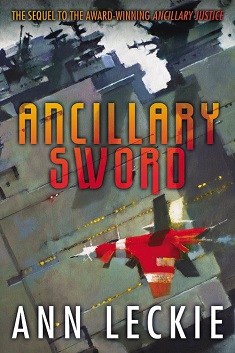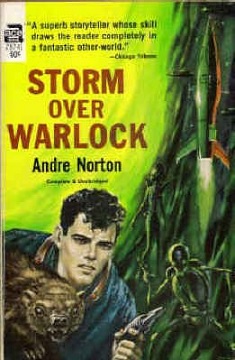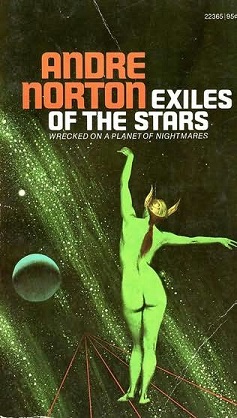
Ancillary Sword
Ann Leckie
356 pages
published in 2014
Ann Leckie’s debut novel, Ancillary Justice, won about every major science fiction award going: the BSFA, the Clarke, The Nebula and the Hugo, the first time any author won the four most important awards in the field with the same book, let alone with their debut novel. Anticipation has therefore been high for the sequel, not least on my part. Would Leckie been able to keep up the high standard of her debut? Would Ancillary Sword build up on it or be more of the same? Is Ann Leckie really the major new sf talent she seems to be or just a flash in the pan?
The main reason for Ancillary Justice‘s impact was Leckie’s use of gender. The Radchaai culture she created uses female pronouns exclusively, making no distinction between male and female in their language. but it goes further than just mere language. Leckie’s protagonist, Breq, struggles with establishing gender, has to consciously evaluate gender clues even when she does speak a gendered language. Possibly this is because she’s an ancillary — one of the meat puppet extensions of a ship AI — because from what we saw in the first novel other Radchaai had no such difficulties. Breq is also the last surviving part of her ship AI because her ship, The Justice of Toren was killed by the immortal ruler of the Radch, Anaander Mianaai, at war with herself.
As Ancillary Sword opens, the civil war between Anaander Mianaai factions has come into the open due to the events of Ancillary Justice. She’s only been able to rule for so long and over such a large volume of space by making use of the same technology that enabled ancillaries to exist, by raising clone bodies and using implants to keep her memories aligned with each over. Over time it was of course inevitable that two or more Mianaais would get out of sync, develop their own vision on how the Radchaai should be run but until now this had been a hidden war. No longer.
Breq is caught up in the middle of it, was in fact its catalyst and now is sent by one faction of Mianaai to Athoek Station where Basnaaid Elming lives, sister to Breq’s old lieutenant Awn, the one she had murdered herself on orders of Anaander Mianaai. Breq only let herself be sent to keep Athoek system safe because of Basnaaid, to atone for her actions.
Once an independent system but long since conquered by the Radchaai, Athoek is one of the major tea producers of the Radch, providing some of its most valued tea, valued especially because it’s all handplucked. Not by the Athoeki themselves anymore, but by Valskaayan workers originally imported from off planet. The station itself is home to the system’s governor and the political elite, as well as the famous garden where Basnaaid works as chief horticulturist. Underneath the garden, in part of the station that doesn’t officially exist anymore, is where the slums are.
When Breq arrives in the system, it’s not long before she finds out the corruption and exploitation inherent in the system as it’s set up. With her power as fleet captain she sets out to change this, though she doesn’t state this in so many words, rather let’s her actions speak. Instead of lodging at the governor’s mansion, she takes up residence in the Undergardens. She also becomes involved in the affairs of the richest of the tea planters, Fosyf Denche and her family.
Whereas you might have expected, after the way Ancillary Justice ended, that Ancillary Sword would revolve around the Mianaai civil war with Breq playing a central role in it, this instead continues the theme of colonial justice that the former book also revolved around. The Radch is a colonial, caste system, with the Radchaai on top and anybody who isn’t Radchaai, who isn’t a citizen, is inferior. Within the Radchaai themselves there are very many fine distinctions, not just in terms of aristocracy, but also amongst the various conquered peoples that have been “civilised”. Some, like the Valskaayans working the tea plantations are still seen as uncivilised if technically with the same rights as other Radchaai.
Breq coming to this system and setting out to change it through the powers vested into her as a fleet captain in service to Anaander Mianaai, reminded me of Nikolai Gogol’s the Inspector General. That idea that corruption can be rooted out if only a honest representative of the czar would visit. But as the Russian saying has it, the cossacks always work for the czar. Leckie, like Gogol, is under no illusions that this is true and shows that the exploitation in Athoek is endemic because of Anaander Mianaai, not in spite of her. Breq herself plays a part in it just as well, helping those she notices for her own reasons, not necessarily changing the system.
The other major theme carried over from Ancillary Justice is Breq herself, her life as the last surviving component of One Esk, as ancillary who no longer has her fellow ancillaries around her. The ship she now captains, The Mercy of Kalr, doesn’t contain any ancillaries, just humans trained by their previous captain to behave as ancillaries. Breq now also misses the abilities she had previously to be omniscient, though through the link with her new ship she can still keep tabs on her officers and crew. That of course also has the useful function of keeping us informed of what happens outside of Breq’s own viewpoint. It’s a clever trick.
I got Ancillary Sword last Thursday and if it wasn’t for me needing to finish the Andre Norton novel I was reading, I would’ve finished it immediately. This is the sort of novel you want to finish in one big gulp until you’re about twothirds of the way through and then you just don’t want it to end quickly. Leckie has only improved as a writer even if the novelty value of her gender relations has worn off. With Ancillary Sword Leckie has proved it wasn’t a gimmick, nor she a flash in the pan. The only thing I can grumble about now is that it will take another year before we get the next book.



